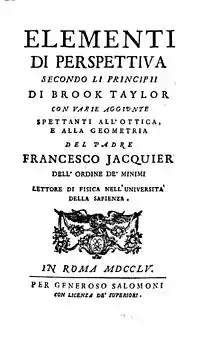François Jacquier
François Jacquier (7 June 1711 at Vitry-le-François – 3 July 1788 at Rome) was a French Franciscan mathematician and physicist.

Life
His early education was entrusted to an ecclesiastic, who recognized in him an inclination to science and mathematics. When sixteen years old, François, entered the Order of Friars Minor, and after profession was sent to Rome, to complete his studies in the French convent of the order, Trinità dei Monti. With the permission of his superiors he specialized in mathematics, and at the same time studied the ancient languages. He became proficient in Hebrew, and spoke Greek as though it were his mother-tongue.
His learning gained for him the patronage of Cardinal Alberoni and Cardinal Portocarrero. He accompanied Cardinal Alberoni on his legation to Ravenna, and was appointed to inspect the work begun by Eustachio Manfredi to prevent the repeated floods of that territory. On his return he was given the chair of Sacred Scripture at the College of the Propaganda, and was also detailed by the general chapter of the Friars Minors, assembled at Marseilles, to work upon the annals of the order.
The King of Sardinia named him professor of physics at the University of Turin in 1745, but Cardinal Valenti, prime minister of Pope Benedict XIV had him assigned to the chair of experimental physics at the Roman College. Here he was in demand for consultation on scientific matters.
In 1763 he was appointed instructor in physics and mathematics to the young Prince Ferdinand at Parma. He was appointed in 1773 to the chair of mathematics at the Roman College, on the occasion of the suppression of the Jesuits. At his death he was connected with nearly all the great scientific and literary societies of Europe. He had been elected a Fellow of the Royal Society in 1741.[1]
Works


The most important of his works are:
- Isaaci Newtoni philosophiæ naturalis principia mathematica, perpetuis commentariis illustrata (4 parts in 3 vols. 4to, Feneva, 1739–42), in collaboration with P. Lesuer;
- Elementi di perspectiva secondo I principi di Taylor (8 vo, Rome, 1745);
- Institutiones Philosophicæ ad studia theologica potissimum accommodata (6 vols. in 12 mo, Rome, 1757), reprinted many times at Rome, Venice, and in Germany, and later translated into Spanish;
- Eléments du calcul intégral (4to, Parma, 1768), a work highly esteemed and more complete than any that had been published up to that time.
- Elementi di perspettiva (in Italian). Salomoni, Giovanni Generoso. 1755.
- De veteri quodam solari horologio nuper invento epistola (in Latin). 1765.
References
- "Fellows details". Royal Society. Retrieved 23 January 2017.
External links
- Jean-Christophe Stuccilli, "Un inédit romain de Laurent Pécheux : le portrait du père François Jacquier", Studiolo, 8 - 2010, p. 185-194.
- Source
![]() This article incorporates text from a publication now in the public domain: Herbermann, Charles, ed. (1913). Catholic Encyclopedia. New York: Robert Appleton Company. Missing or empty
This article incorporates text from a publication now in the public domain: Herbermann, Charles, ed. (1913). Catholic Encyclopedia. New York: Robert Appleton Company. Missing or empty |title= (help)